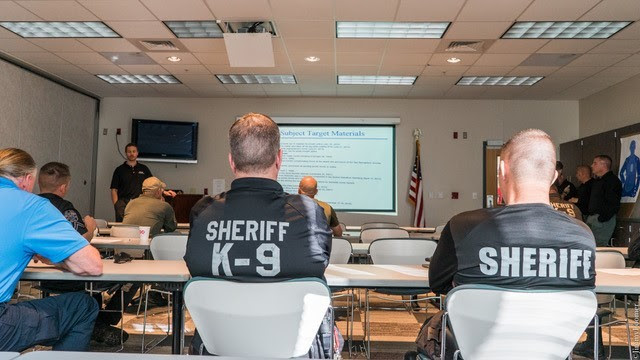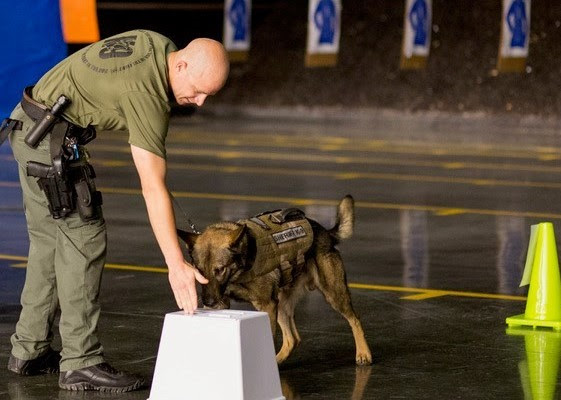 Dogs are uniquely suited to sniffing out explosives – their sense of smell is more than a million times stronger than a human’s. Harnessing this natural ability to help law enforcement identify explosives requires specialized training and testing. Many detection canine teams, however, have limited access to critical training materials and limited time to establish rigorous training scenarios. The Department of Homeland Security (DHS) Science and Technology Directorate’s (S&T) Detection Canine Program has developed an initiative to support these needs for the nation’s more than 4,000 explosives detection canine teams.
Dogs are uniquely suited to sniffing out explosives – their sense of smell is more than a million times stronger than a human’s. Harnessing this natural ability to help law enforcement identify explosives requires specialized training and testing. Many detection canine teams, however, have limited access to critical training materials and limited time to establish rigorous training scenarios. The Department of Homeland Security (DHS) Science and Technology Directorate’s (S&T) Detection Canine Program has developed an initiative to support these needs for the nation’s more than 4,000 explosives detection canine teams.
The DHS S&T Detection Canine Program, part of S&T’s Homeland Security Advanced Research Projects Agency’s Explosives Division, has created the Regional Explosives Detection Dog Initiative (REDDI), a series of events aimed at advancing the knowledge and capabilities of the nation’s detection canine teams. 
“We are setting up real-world problems,” said Don Roberts, DHS S&T Detection Canine Program Manager. “REDDI seeks to improve the operational effectiveness of the law enforcement explosive detection canine teams while informing S&T on where our research investment needs to be focused going forward.“
In March 2017, the Detection Canine Program kicked off REDDI to share knowledge and provide exercises in basic odor recognition and realistic operational search scenarios. REDDI began with the first event in Fort Myers, Florida, and moved to Westport, Connecticut, in April. Miami, Florida, is scheduled to host REDDI in late May, and plans are underway to continue REDDI through 2018. Up to 20 explosives detection canine teams participate in each two-day program, which includes classroom presentations on current explosive threats and the chemistry of explosives, as well as odor recognition trials and operational searches. The goal is to improve explosive detection canine team training effectiveness and efficiency in order to improve overall operational proficiency.
REDDI provides a realistic setting where law enforcement teams from several jurisdictions can evaluate their detection capabilities, understand their strengths, and identify additional training needs. The DHS detection canine research program benefits from REDDI in that it validates current investments and informs the direction of future research. Participation in a REDDI event is often the first opportunity a local law enforcement explosive detection canine team has to assess their capabilities in authentic, real world scenarios, with scientifically rigorous oversight by DHS S&T.
S&T has funded two tools to strengthen the impact of REDDI – non-hazardous peroxide training aids and a custom-developed data collection tool. S&T partnered with the Johns Hopkins University Applied Physics Laboratory to develop non-hazardous, non-detonable canine training aids made with actual peroxide-based explosives through a patented process. These training aids can be used anywhere, require no special handling or storage requirements, and provide explosives detection canine teams more opportunities to train with the peroxides in operational settings.
“The problem is that these are sensitive explosives,” said Roberts. “They are difficult to train with, and the teams aren’t getting the frequency of training we feel might be necessary to stay proficient. Having non-hazardous training aids allows the teams to train with the peroxide material in the operational environment, like airports, stadiums or in mass transit.”
S&T is also using the Mobile Application for Canine Evaluation, or MACE, a tablet-based data collection tool developed by S&T partner Battelle Memorial Institute, to provide immediate feedback at REDDI events to canine teams and their trainers. MACE compiles performance data in real time, which makes it possible for S&T to efficiently and effectively conduct REDDI as a two-day event.
“The explosives detection canine is the best, most versatile mobile explosive detection tool at our disposal for protecting the Homeland from the explosive threat,” said Roberts, “and DHS S&T’s mission is to provide tools, techniques and knowledge to better understand, train and utilize explosive detection canine teams in the operational environment.”
To learn more about REDDI, read the program factsheet or contact the team at SandT.explosives@hq.dhs.gov.
